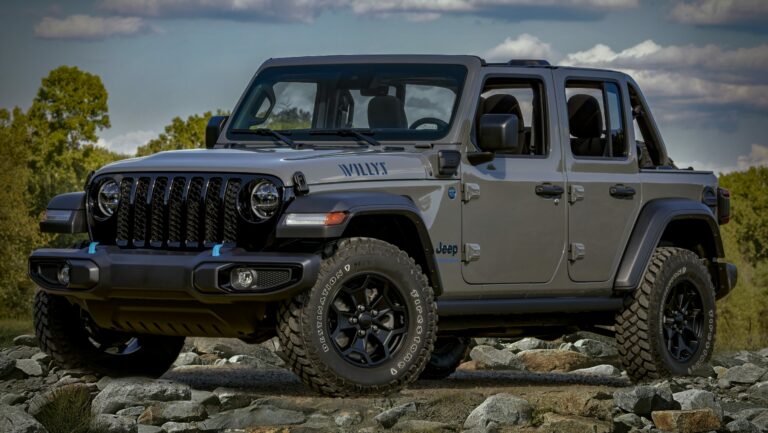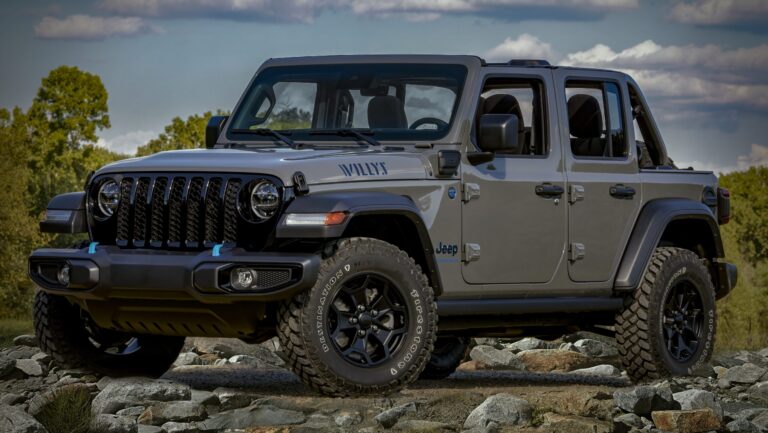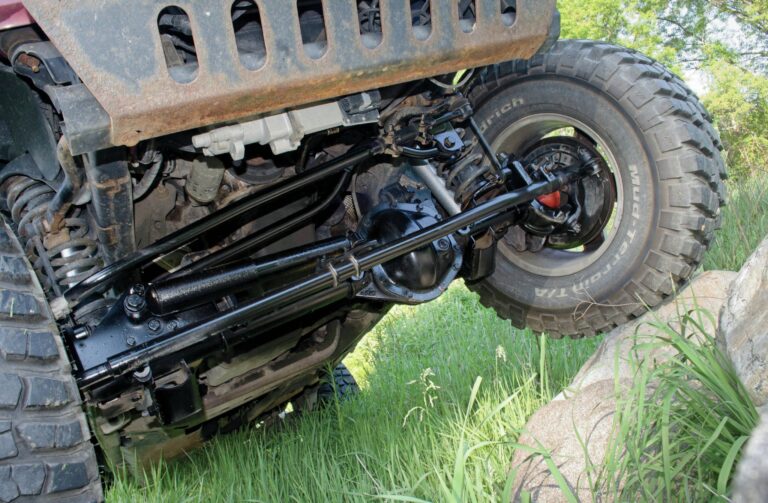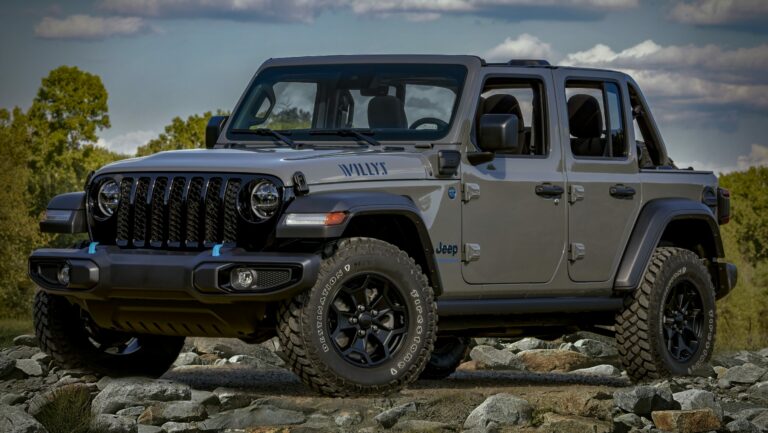46 Willys Jeep For Sale: Your Comprehensive Guide to Owning an American Icon
46 Willys Jeep For Sale: Your Comprehensive Guide to Owning an American Icon jeeps.truckstrend.com
The call of the open road, or perhaps the untamed trail, often beckons enthusiasts to vehicles that embody rugged simplicity and enduring legacy. Among these, the 46 Willys Jeep For Sale stands as a true American icon, a testament to post-war ingenuity and the birth of civilian utility vehicles. More than just a mode of transport, a 1946 Willys Jeep CJ-2A represents a piece of living history, a tangible link to a pivotal era that shaped modern motoring.
This comprehensive guide is designed for anyone considering the purchase of a 46 Willys Jeep, whether you’re a seasoned collector, an off-road adventurer, or simply a nostalgic admirer. We’ll delve into what makes these vehicles so special, what to look for, and how to navigate the journey of acquiring and owning one of these legendary machines.
46 Willys Jeep For Sale: Your Comprehensive Guide to Owning an American Icon
The Enduring Legacy of the 1946 Willys Jeep CJ-2A
The "46 Willys Jeep" specifically refers to the Willys-Overland CJ-2A, the first civilian-production Jeep. While some late 1945 models exist, the 1946 model year truly launched the CJ-2A into the public consciousness. Born from the legendary military MB and GPW Jeeps that served valiantly in World War II, the CJ-2A was Willys-Overland’s answer to a nation yearning for versatile, affordable, and durable transportation after years of wartime rationing.
The CJ-2A retained the military Jeep’s robust four-wheel-drive system, short wheelbase, and the iconic "Go-Devil" flathead four-cylinder engine. However, it introduced civilian-friendly features like a tailgate, side-mounted spare tire, larger headlights, a redesigned grille, and an array of color options beyond olive drab. It quickly found its niche on farms, ranches, and in countless small businesses, proving its mettle as a workhorse before evolving into the recreational vehicle we know and love today. Its importance lies not just in its utility, but in laying the groundwork for every Jeep that followed, cementing its place as the patriarch of the modern SUV.
Key Features and Specifications of a 1946 Willys CJ-2A
Understanding the core components of a 46 Willys Jeep is crucial for any potential buyer. These vehicles are characterized by their mechanical simplicity and robust construction, which contributes to their longevity and repairability.
- Engine: The heart of the CJ-2A is the 134 cubic inch (2.2L) "Go-Devil" L-head (flathead) four-cylinder engine. Known for its torque at low RPMs and legendary reliability, it produces around 60 horsepower. While not fast by modern standards, it’s remarkably capable for its intended purpose.
- Transmission: Most CJ-2As came with a Warner T-90 three-speed manual transmission, synchronized in second and third gears. It’s a tough, reliable unit that pairs well with the Go-Devil engine.
- Transfer Case: A two-speed Dana 18 transfer case provides both high and low ranges, allowing for excellent off-road capability. It engages 4WD when desired.
- Axles: Typically, a Dana 25 front axle and a Dana 41 or Dana 44 rear axle were used, providing robust power delivery to all four wheels.
- Body and Frame: The CJ-2A features a sturdy ladder frame and a simple, boxy steel body. Early models are identifiable by their "short" hood, seven-slot grille, and a body-mounted fuel tank filler neck. Many original features like the "Willys" script on the hood and tailgate, and the distinct flat fenders, are hallmarks.
- Electrical System: Originally a 6-volt positive ground system, many have been converted to 12-volt negative ground for easier starting and accessory compatibility.

Benefits of Owning a 46 Willys Jeep
Acquiring a 46 Willys Jeep is more than just buying a vehicle; it’s an investment in history, a unique driving experience, and an entry into a passionate community.
- Historical Connection: Own a piece of American post-war history. These vehicles represent a pivotal moment in automotive design and civilian adaptation.
- Unmatched Character: Each CJ-2A has a story. Their rugged, no-frills design, combined with the patina of age, gives them an undeniable charm that modern vehicles simply can’t replicate. They are guaranteed head-turners.
- Simple Mechanics: For those who enjoy working on their own vehicles, the CJ-2A is a dream. Its mechanical simplicity means most repairs can be tackled with basic tools and a good manual, fostering a deep understanding and connection with the machine.
- Off-Road Prowess: Despite their age, 46 Willys Jeeps remain incredibly capable off-road. Their light weight, short wheelbase, and robust 4WD system allow them to tackle terrain that would challenge many modern SUVs.
- Strong Community and Parts Availability: A vibrant global community of Willys Jeep enthusiasts exists, offering a wealth of knowledge, support, and friendship. Furthermore, the aftermarket for CJ-2A parts is surprisingly robust, with many reproduction and NOS (New Old Stock) components readily available.
- Potential Investment: Well-maintained or professionally restored 46 Willys Jeeps can appreciate in value, making them not just a hobby but potentially a sound investment.
Important Considerations Before You Buy
Purchasing a vintage vehicle, especially one as old as a 46 Willys, requires careful consideration. Thorough research and inspection are paramount.
- Rust is the Enemy: The most significant concern for any vintage steel vehicle is rust. Inspect the frame rails, body tub (especially the floorboards, hat channels, and rear corners), fenders, and firewall. Surface rust is manageable, but extensive rot requires costly and time-consuming repairs.
- Mechanical Condition: Evaluate the engine (look for smoke, strange noises, leaks), transmission (smooth shifting, no grinding), transfer case, and axles (fluid leaks, play in U-joints). Test the brakes thoroughly.
- Originality vs. Restoration: Decide whether you want an original, unrestored "survivor" with its authentic patina, or a fully restored show vehicle. Originality often commands a premium, but restorations can be costly. Be wary of "patchwork" restorations that hide underlying issues.
- Title and VIN Verification: Ensure the vehicle has a clear, transferable title that matches the VIN plate (usually found on the firewall). Some older vehicles may have lost their original titles, complicating registration.
- Modifications: Many CJ-2As have undergone modifications over the decades (e.g., 12-volt conversion, engine swaps, power steering). While some modifications can enhance usability, others might detract from originality or indicate hidden problems. Understand what has been changed.
- Budget Beyond Purchase Price: Factor in potential restoration costs, immediate repairs, ongoing maintenance, insurance, and possibly storage. These can easily exceed the initial purchase price.
Where to Find a 46 Willys Jeep For Sale
Locating your ideal 46 Willys Jeep requires knowing where to look.
- Online Marketplaces: Websites like eBay Motors, Craigslist, Hemmings, and dedicated classic car sales platforms (e.g., ClassicCars.com, Bring a Trailer) frequently list CJ-2As.
- Specialized Forums and Clubs: Forums like The CJ2A Page, G503, and local Willys Jeep clubs are excellent resources. Members often sell vehicles directly, and you can tap into a wealth of collective knowledge.
- Classic Car Dealers: Some dealerships specialize in vintage vehicles and may have restored or driver-quality CJ-2As. Prices here might be higher, but vehicles are often vetted.
- Auctions: Major classic car auctions (e.g., Mecum, Barrett-Jackson) occasionally feature high-quality restored Willys Jeeps. Smaller, local auctions can also yield hidden gems.
- Word-of-Mouth: Let friends, family, and local mechanics know you’re looking. You’d be surprised what forgotten treasures are sitting in barns or garages.
The Buying Process: Practical Advice
Once you’ve found a potential candidate, a systematic approach to inspection and negotiation is key.
- Initial Contact: Ask detailed questions about the vehicle’s history, condition, and any known issues. Request extensive photos and videos.
- In-Person Inspection: If possible, inspect the vehicle in person. Bring a flashlight, a magnet (to detect body filler), and a knowledgeable friend if you’re not mechanically inclined.
- Exterior: Check for rust, body alignment, and quality of paint.
- Interior: Look at the seats, gauges, steering wheel, and floorboards.
- Undercarriage: This is critical. Inspect the frame for cracks, bends, or severe rust. Check suspension components, brake lines, and exhaust.
- Engine Bay: Look for leaks, signs of recent work (good or bad), and the general cleanliness.
- Test Drive: If the vehicle is running, take it for a drive.
- Listen for unusual noises from the engine, transmission, and axles.
- Test the brakes: do they pull? Is the pedal firm?
- Check all gears, including reverse and 4WD (if safe to engage).
- Note steering play and suspension feel.
- Documentation: Verify the title matches the VIN. Ask for any maintenance records or restoration receipts.
- Negotiation: Be prepared to negotiate. Use any identified flaws as leverage. Research recent sales of similar vehicles to understand fair market value.
- Pre-Purchase Inspection (PPI): For higher-priced or seemingly pristine vehicles, consider hiring a specialist mechanic to perform a PPI. It’s a small investment that can save you from costly surprises.
Restoration vs. Driver Quality: What’s Right for You?
The condition of a 46 Willys Jeep can range from a rust bucket project to a concours-level restoration. Your budget, mechanical aptitude, and intended use will dictate which is best.
- Project/Parts Vehicle: These are typically non-running, incomplete, or heavily rusted. They are the cheapest to acquire but require significant investment in time, money, and skill. Ideal for experienced restorers or those seeking parts.
- Running Driver: This is a popular category. The vehicle starts, runs, drives, and stops, but may have cosmetic flaws, minor mechanical issues, or older repairs. They offer immediate enjoyment and can be improved over time. More affordable than fully restored models.
- Nicely Restored/Show Quality: These vehicles have undergone extensive, professional restoration. They are often pristine, historically accurate, and command the highest prices. Ideal for collectors, show enthusiasts, or those who want a turn-key classic.
Maintenance and Ownership Tips
Owning a 46 Willys is a rewarding experience, but it does require ongoing care.
- Regular Checks: Adhere to a strict maintenance schedule. Check all fluids (oil, transmission, transfer case, differentials, brake fluid) regularly.
- Lubrication: These old machines have many grease points. Keep them well-lubricated to prevent premature wear.
- Ignition System: The original points and condenser system needs periodic adjustment or replacement. Many owners opt for electronic ignition conversions for reliability.
- Cooling System: Ensure the radiator is clean, hoses are in good condition, and the thermostat functions correctly to prevent overheating.
- Rust Prevention: Keep the vehicle clean and dry. Address any new rust spots immediately. If stored, ensure proper ventilation.
- Find a Community: Join Willys Jeep forums and clubs. The collective wisdom of experienced owners is invaluable for troubleshooting, sourcing parts, and getting advice.
Potential Challenges and Solutions
While robust, owning a 46 Willys can present unique challenges.
- Rust Repair: Extensive rust can be a major undertaking, requiring welding and fabrication skills. Solution: Professional body shops specializing in classic cars, or learn to weld.
- Engine/Drivetrain Rebuilds: If neglected, the engine, transmission, or axles may require rebuilding. Solution: Seek out reputable machine shops or mechanics experienced with vintage engines, or consider a DIY rebuild with readily available kits.
- Electrical Gremlins: The original 6-volt system can be finicky, leading to dim lights or starting issues. Solution: Thoroughly clean all grounds, inspect wiring, or consider a 12-volt conversion (which simplifies starting and allows for modern accessories).
- Finding Skilled Mechanics: Not all mechanics are familiar with vintage vehicles. Solution: Look for specialized classic car shops or connect with experienced owners in your local Willys club for recommendations.
- Slow Road Speed: A 46 Willys is not built for highway cruising. Its top speed is typically 45-55 mph. Solution: Embrace the slower pace, use it for local driving, off-roading, or short parades. Some owners swap in higher ratio differentials for slightly better road manners, but this sacrifices low-end torque.
Price Guide: 1946 Willys Jeep CJ-2A For Sale
The price of a 1946 Willys Jeep can vary dramatically based on its condition, originality, and location. The table below provides a general guide.
| Condition Category | Estimated Price Range (USD) | Key Influencing Factors |
|---|---|---|
| Project / Parts Vehicle | $1,500 – $6,000 | Incomplete, non-running, significant rust, major mechanical issues, missing title. For experienced restorers only. |
| Running Driver | $7,000 – $18,000 | Starts, runs, drives, and stops. May have cosmetic flaws, minor leaks, some rust, or non-original parts. Usable now. |
| Nicely Restored | $19,000 – $35,000+ | Professionally restored, good paint, minimal rust, solid mechanics, mostly original components. Ready for shows/tours. |
| Concours / Show Quality | $35,000 – $60,000+ | Meticulously restored to original specifications, historically accurate, pristine condition. Often trailered. |
Note: These ranges are estimates and can fluctuate based on market demand, regional differences, specific modifications, and the completeness of documentation. A rare, early production model or one with unique historical provenance could command a higher price.
Frequently Asked Questions (FAQ) about the 46 Willys Jeep
Q: Is a 1946 Willys Jeep a good daily driver?
A: Generally, no. While incredibly reliable, their low top speed, lack of modern safety features (airbags, ABS, crumple zones), and rudimentary heating/cooling systems make them unsuitable for daily commuting or long highway trips. They excel as weekend cruisers, off-road vehicles, or parade vehicles.
Q: Are parts for a 46 Willys Jeep hard to find?
A: Surprisingly, no! Due to the sheer number produced and their simple design, there is a robust aftermarket for new reproduction parts, as well as a good supply of used and New Old Stock (NOS) parts. Many specialized vendors cater specifically to Willys Jeeps.
Q: What’s the difference between a military Jeep and a CJ-2A?
A: The CJ-2A (Civilian Jeep) was developed directly from the military MB and GPW. Key differences include a tailgate, side-mounted spare tire, larger headlights, a redesigned grille, a different fuel filler location, and civilian color options. Mechanically, they share many components.
Q: Can I take a 46 Willys Jeep off-roading?
A: Absolutely! The 46 Willys CJ-2A is legendary for its off-road capability. Its short wheelbase, light weight, and robust 4WD system make it highly agile and capable on trails. However, remember its age and mechanical limitations; avoid extreme obstacles that could cause damage.
Q: Should I convert my 6-volt system to 12-volt?
A: Many owners do. A 12-volt conversion typically involves replacing the generator with an alternator, changing the battery, coil, and possibly some gauges and lights. It makes starting easier, allows for modern accessories (radio, phone charger), and simplifies troubleshooting. However, it sacrifices originality.
Q: What is the typical fuel economy?
A: Expect around 15-20 miles per gallon, depending on driving conditions, vehicle tune, and gearing. It’s not designed for fuel efficiency.
Conclusion: Embracing the Willys Experience
The journey of finding and owning a 46 Willys Jeep For Sale is an adventure in itself. These vehicles are more than just metal and rubber; they are living relics that offer a unique blend of historical significance, mechanical simplicity, and unparalleled character. While they demand a certain level of commitment in terms of maintenance and understanding, the rewards – from the smiles and waves you’ll receive to the sheer joy of piloting such a rugged, authentic machine – are immeasurable.
Whether you envision a fully restored showpiece, a reliable weekend driver, or an unpretentious off-road companion, the 1946 Willys CJ-2A promises a genuine connection to automotive history. Embrace the quirks, learn the mechanics, and join the passionate community that celebrates this true American icon. Your adventure with a 46 Willys Jeep is waiting.



